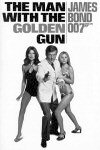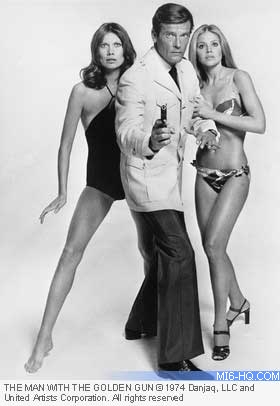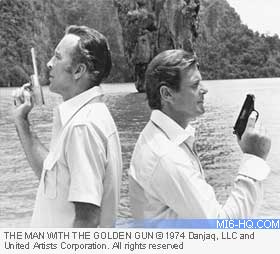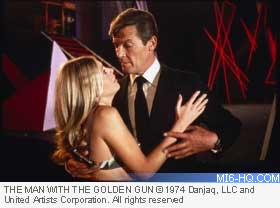|
|
|
 |
| |
According to reviewers at the time, the only
thing golden about James Bond's ninth cinematic
adventure was Scaramanga's gun. MI6 looks back at
the critical
mauling...
|
|
All That Glistens Isn't Gold
15th May 2007
When Roger
Moore's second outing as 007 burst on to
cinema screens only a year after the successful "Live
And Let Die", fans were set to enjoy a James Bond
film with the same lead actor as the previous film for
the first time since "You
Only Live Twice". But
according many critics at the time, the only continuity
in the series worth mentioning was the steadily declining
quality of the films.
Time Magazine offered a cutting review
of "The Man With The
Golden Gun" on
January 14th 1975, a few weeks after the film had limped
off the starting blocks at the box-office.
"This is a James Bond caper and, as in the previous
eight, there are plenty of fancy gadgets. Two are worthy
of special note. One is a car that converts into an airplane
(a bit of a bore; flying autos have already shown up in
Popular Mechanics). The other, also a car, is less flashy.
It merely moves in the air between the banks of a river
and spins three times like a huge eggbeater before coming
to rest, upright, on the far side. Now that is not as elaborate
as the ability to take wing, but there is something elegant
in the simplicity and unexpectedness of the spin." |
|

Above: Maud Adams, Roger Moore and Britt Ekland. |
"The flying car, in fact, is much like what is wrong with
The Man with the Golden Gun and what has been wrong with the
whole
Bond series for a while. Overtricky, uninspired, these exercises
show the strain of stretching fantasy well past wit. The best
Bonds, like the car that twirls, were sly without quite getting
silly."
 |
|
"The best Bonds also had Sean
Connery, whose absence
is sorely felt here. An actor of considerable resource,
Connery played 007 with just the right combination of conviction
and detachment. He also had a self-mocking aplomb that
would be hard to duplicate. His Bond is definitive.
Roger
Moore, who first played 007 in Live and Let Die (1973),
lacks all Connery's strengths and has several deep deficiencies.
He has all the worldliness of a floorwalker, and looks
as if his last adventure were spending two weeks in a Swiss
clinic getting a facelift."
|
"For the record, The Man with the Golden Gun finds Bond
chasing around Southeast Asia in pursuit of an assassin named
Scaramanga who gets $1 million per contract for the use of his
gold weapon."
There is the usual action (fights, pursuits,
assignations), the usual bantamweight grotesqueries. Scaramanga's
evil henchman is a dwarf, and Scaramanga himself (Christopher
Lee), an unusually unimpressive villain, would be a dead
cinch to spot on a beach since he has three nipples. Nothing
much happens to any of these characters that has not happened
before, and better. Maud
Adams and Britt Ekland do, however,
make a couple of mildly decorative, active heroines in
a series notably short on them (Diana
Rigg, in On
Her Majesty's Secret Service, being the sole other exception)."
|
|

|
Although the final screen credits promise that Bond will return
in The Spy Who Loved Me, it is time to retire him. He should
be packed off to a sanitarium, where he can give his liver a
rest and wait in leisure for his moment to come again. Right
now, Bond has been around too long to be fresh, but not long
enough to qualify as a genuine antique."
In the three years following the poor performance
of "The
Man With The Golden Gun", producers Harry Saltzman
and Cubby Broccoli would part company, leaving the latter at
the helm of the franchise.
Broccoli successfully rejuvenated the Bond series in 1977 with "The
Spy Who Loved Me", which took over double the previous
film's US box-office.
Related Articles
 The
Man With The Golden Gun - Movie Coverage The
Man With The Golden Gun - Movie Coverage
|
|
|